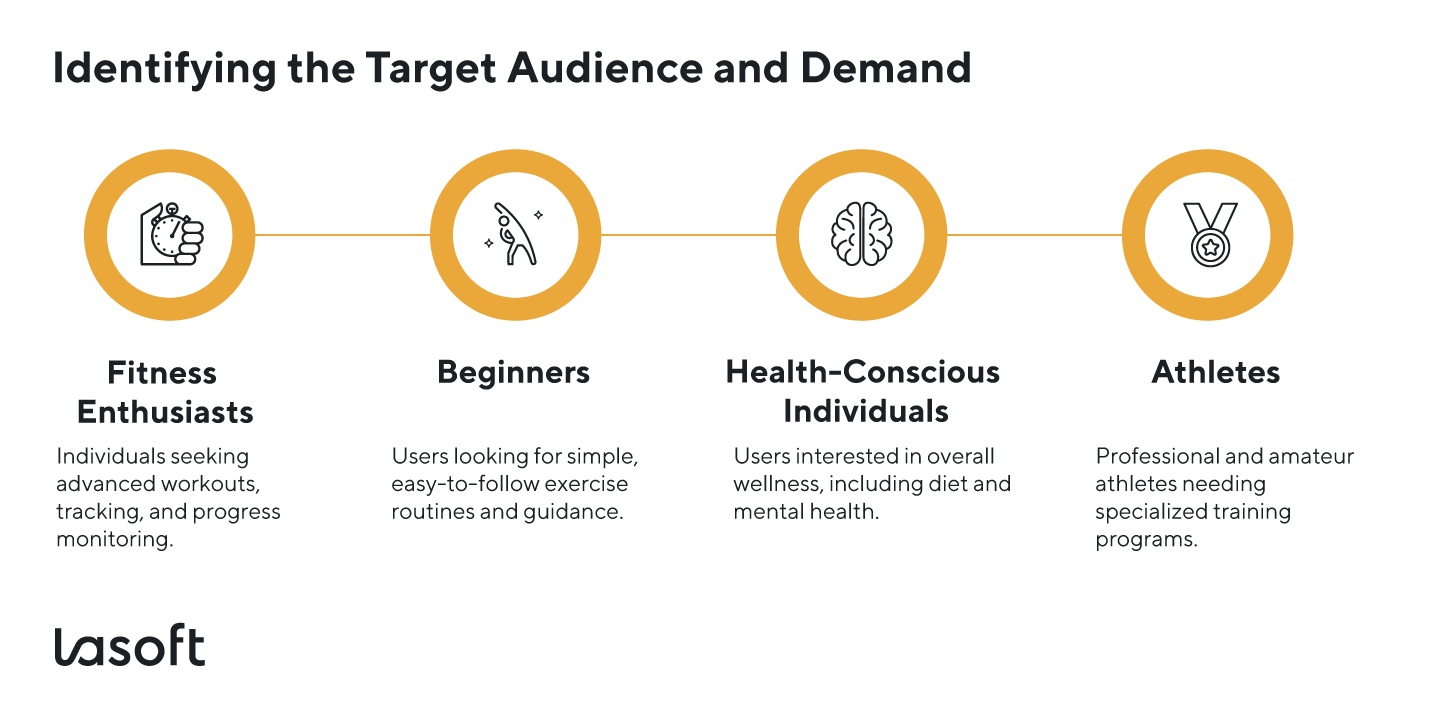The 21st-century world is becoming increasingly health-conscious and eco-friendly, presenting a compelling opportunity for startups in the wellness and fitness app market as the demand for personalized, accessible, and innovative fitness applications continues to surge. A successful fitness app with intuitive navigation and useful features can tap into this growing trend, offering users personalized workout plans, progress tracking, and community engagement.
Investing in fitness app development is not just about joining a “green” trend in the market; it’s about contributing to a healthier lifestyle for many people. With the right features and user experience, your app can stand out in a competitive field and drive significant user engagement. Our fitness app development company offers a comprehensive guide to help you create a functional fitness app that meets the requirements and needs of potential users.
Fitness Apps Niche Review as a Part of the Sportech Market
The health and fitness apps niche is rapidly expanding in the mobile app market, as the number of people prioritizing health and wellness is also growing. Still, the fitness app market is very competitive. Many apps are trying to grab users’ attention.
A driving force in the fitness mobile app development industry is wearable technology. Software development teams design fitness apps to sync with IoT devices such as smartwatches and fitness trackers. The benefits are obvious: providing users with activities and progress tracking, various exercise options, calorie tracking features, etc. Additionally, these apps incorporate social features to connect with friends, compete, share achievements, and engage in fitness communities and chats, boosting user motivation and engagement.
Fitness App Development Market Revenue Change
- 2017
- 0.11
- 2018
- 0.21
- 2019
- 0.42
- 2020
- 0.94
- 2021
- 1.95
- 2022
- 3.13
- 2023
- 5.00
- 2024
- 6.86
- 2025
- 8.30
- 2026
- 9.22
- 2027
- 9.74
- 2028
- 10.04
- 2029
- 10.06
Source: Statista
By Statista, revenue is expected to show an annual growth rate (CAGR 2024-2029) of 7.96%, resulting in a projected global fitness app market volume of US$10.06bn by 2029.
Fitness apps are gaining traction among users of all age groups, with adults aged 18 to 64 utilizing them for physical activity and weight management or focusing more on diet and nutrition.
Due to the effectiveness of these apps, the industry is experiencing a surge in investment. Modern technologies, including machine learning, artificial intelligence, and augmented reality, are revolutionizing the fitness industry.
These innovations enable sports and fitness businesses to offer fitness app development services and mobile fitness apps with options like downloading personalized parameters: weight, height, and contraindications due to health. They also offer monitoring of weight training, workout plans, professional recommendations, and meditation, both online and in-person at gyms.
Identifying the Target Audience and Demand
Understanding your target audience helps develop a fully functional fitness app that resonates with users. Key segments include:
| Fitness Enthusiasts: | Individuals seeking advanced workouts, tracking, and progress monitoring. |
| Beginners: | Users who are looking for simple, easy-to-follow exercise routines and guidance. |
| Health-Conscious Individuals: | Users who are interested in overall wellness, including diet and mental health. |
| Athletes: | Professional and amateur athletes needing specialized training programs and positive habit development apps. |

Types of Fitness Apps
| Wellness Apps, Workout Apps, and Activity Tracking Apps | Provides users with structured workout plans, exercise routines, and instructional videos. Those apps usually offer their users customizable workout schedules, video demonstrations, progress tracking, and goal setting. Those apps monitor and record daily physical activities, such as steps taken, distance traveled, and calories burned. To cover all those purposes, developers use GPS tracking, activity logs, step counters, and integration with wearable devices like Apple watches. |
| Health and Fitness App | Offers a comprehensive approach to health, combining fitness tracking with additional health insights. These apps include activity tracking, sleep monitoring, heart rate tracking, and wellness assessments. |
| Personal Training App and AI-Powered Coaching Apps | Provides personalized training programs and virtual coaching to help users achieve their fitness goals. Fitness app developers usually cover here custom workout plans, live coaching sessions, goal tracking, and personalized feedback. Artificial intelligence often helps provide customized training plans, feedback, and coaching to enhance users’ fitness routines. |
| Diet and Nutrition Apps and Wellness App Solutions | Assists users in managing their diet and nutrition to support their fitness and health goals. These apps help with meal planning, calorie counting, nutrition tracking, and recipe suggestions. |
| Yoga Apps | Offers guided yoga sessions and routines to improve flexibility, strength, and mental relaxation. As a user, you can get yoga routines for different levels, instructional videos, progress tracking, and breathing exercises. |
| Meditation Apps | Most meditation apps operate on a freemium + subscription model, enabling consistent MRR (monthly recurring revenue) as target users develop long-term habits. Modern apps use AI to recommend meditations based on mood, time of day, behavior patterns, or even biometric data from wearables. |
Those fitness app features are considered advanced or complex as they generate custom workout plans based on user data and goals. They also provide immediate feedback on exercise form and performance using AI. Advanced functionality helps adjust workout intensity and recommendations based on user progress and feedback, and also analyzes user performance data to optimize training and prevent injuries.
Metaverse Health and Fitness Market
The market involves the use of virtual and augmented reality technologies to offer health and fitness services and information. This covers a wide range of applications, such as virtual personal training, virtual rehabilitation, virtual therapy, and virtual wellness programs. The Metaverse Health and Fitness market is expected to reach a value of US$8.5 billion in 2024. The global market is projected to hit US$56.1 billion by 2030. Additionally, the United States leads this market, contributing the most value to the projected market volume.
Metaverse Health And Fitness Market Size
- 2024
- 8.5
- 2025
- 11.6
- 2026
- 17.1
- 2027
- 25.6
- 2028
- 36.8
- 2029
- 48
- 2030
- 56.1
Source: Statista
VR health and fitness app offers a transforming experience to engage users with sports and fitness activities. VR technology helps apps create interactive environments that enhance training, competition, and enjoyment.
| Virtual Gyms and Sports Arenas: | Users train in simulated environments that mimic actual gyms, or outdoor settings. |
| Interactive Workouts: | VR enables users to participate in workouts guided by a virtual trainer. |
| Metrics: | The app provides real-time updates on user performance metrics, including heart rate, calorie expenditure, and movement accuracy, with instant feedback. |
| Multiplayer Mode: | Users can compete with friends or other players in virtual sports events, races, or fitness challenges. |
| Progress Monitoring and Rewards: | The app features leaderboards and rewards for top performers. Also, users can earn points, unlock achievements, and compete in virtual challenges. |
| Virtual Coaching: | Users receive personalized coaching and feedback from virtual trainers, as well as demonstrations of techniques and correct forms in a 3D environment. |
| Simulations: | The app offers various sports simulations and refining techniques. |
| Virtual Meetups: | Virtual fitness classes or group workouts allow you to connect with others who share your passion for sports and similar fitness goals. |
NOTE!
VR app development has some hardware and tech stack requirements, such as VR headsets and controllers, to fully experience the app’s features. Integrating VR technology also requires a significant investment in development and testing to ensure a smooth and practical user experience.
VR Fitness App Example
The Supernatural VR App (2020) is a cutting-edge virtual reality fitness platform that combines beautiful environments with engaging workouts. This app was designed for users seeking a unique and interactive fitness experience, featuring a variety of physical exercises and virtual exploration. This app leaves users in awe with breathtaking virtual locations, ranging from serene natural landscapes to futuristic cities, enhancing the workout experience with stunning visuals.
Professional trainers guide each workout and offer on-the-spot direction, inspiration, and feedback to ensure participants carry out the exercises effectively. The app also includes guided meditation and relaxation sessions and gives access to recovery tools and techniques designed to improve flexibility, reduce muscle soreness, and enhance overall well-being.
FitXR (2017) is a virtual reality (VR) fitness app designed for people seeking an immersive and engaging way to work out. The app offers various workout styles in a VR environment, combining fitness with gamification to keep users motivated. The subscription provides sports enthusiasts with activities such as boxing, dance, and HIIT (High-Intensity Interval Training), all within a VR setting.
Additionally, this VR app provides a library of on-demand fitness classes led by qualified trainers. Users can join group workouts, making it a social experience to exercise with friends or meet new people. It features user movement tracking and real-time feedback to improve performance and form.
VR Fitness and Sport Apps Examples by Revenue (in million U.S. Dollars) per Year
- Supernatural VR, the USA
- 18.7
- Fit XR, the UK
- 25.9
Examples of Leading Fitness Apps in the Market
Fitbit (2007).
Users can log their food intake, activities, and weight, allowing them to monitor their progress over time. They can set daily and weekly goals for steps, calories burned, calories consumed, and distance walked. Additionally, the fitness app idea includes a community page where users can participate in challenges and compete with others.
Nike Training Club (2016). Nike Training Club offers workout options and training plans. Nike created it to provide a comprehensive approach to fitness that combines strength, endurance, and flexibility exercises to aid users in achieving their health and fitness objectives. It offers customizable training plans, video and audio guidance options, and progress tracking.
Apple Fitness+ (2015). The fitness app integrates relevant metrics and HealthKit data, including heart rate, based on the type of exercise performed. For outdoor activities, it provides summaries that include weather conditions at the time of the workout and a map outlining the route taken during the exercise.
Strava (2009) is an American internet service and workout app that tracks physical exercise and includes social networking features. Initially, it focused primarily on monitoring outdoor cycling and running activities.
PUMATRAC (2013). This cutting-edge fitness application is designed to enhance users’ running and tracking experiences. It combines advanced tracking technology with personalized coaching features, aiming to support and motivate users in achieving their fitness goals. The app tracks key performance metrics such as heart rate, calories burned, and elevation changes to help you assess your workout effectiveness.
Top Fitness and Sport Apps by Revenue (in million U.S. Dollars) per Year
- Fitbit, the USA
- 238.8
- Strava, the USA
- 90.1
- Peloton, Canada
- 78.00
- BetterMe, Ukraine
- 50.00
- MyFitnessPal, the USA
- 34.8
- JustFit, the USA
- 1.8
In January 2024, MyFitnessPal led the fitness apps market, generating over $12 million in in-app revenues. Strava secured the second position, earning approximately $5.68 million in combined revenues from Google Play Store and the Apple App Store. Peloton followed with around $5 million in revenue. At the same time, Fitbit, known for its popular wearable fitness and health tracking devices, generated $4.18 million from its brand app and an additional $4.12 million from its Google-powered app.
Functionalities We Advise To Cover
Our fitness app development company aims to outline key features for personal trainer apps, workout plan apps, and fitness applications. Startups select specific features to implement, ensuring their target audience derives the most significant benefits from the fitness app.
| User Profiles and Personalization: | Users should have the option to create profiles. This option enables you to monitor users’ activity, assist them in setting fitness goals, and provide personalized workout plans tailored to their preferences and progress. |
| Workout Plans and Tracking: | Offer a variety of workout routines, including weight workouts and yoga kriyas, with performance metrics tracking. Users also have the option to set and compare their fitness goals, body parameters, and preferences. |
| Integration with Wearable Devices: | IoT devices like smartwatches and fitness trackers offer synchronization to provide real-time data and insights. |
| Social Features and Community Engagement: | Social features and community engagement are essential options for encouraging users to connect with friends, join fitness challenges, and share achievements, fostering a supportive community around your digital product and attracting fitness influencers. |
| Nutrition Tracking: | It helps log meal recipes and track nutritional intake and eating habits, providing a holistic approach to a healthy lifestyle for your app users. Gamification: Features like badges, rewards, and leaderboards enhance user motivation to achieve goals set and inspire them to move progress forward. |
| Educational Content and Resources: | If your fitness app provides video tutorials, workout videos, articles, tips, and instructions on fitness, nutrition, and overall well-being, users will learn something new. |
| Location-Based Features: | This feature allows the app to map the route taken during workouts and provides detailed summaries for outdoor activities. It displays weather conditions during outdoor exercises to contextualize fitness and wellness activities. |
| Data Security: | This feature ensures that user data is protected against unauthorized access. |
| Free Trial Feature: | It offers users a limited-time free trial period to explore essential features and content within the app. It’s up to you to define its duration, such as 7, 14, or 30 days, allowing users to experience the core app functionalities. Implementing automatic enrollment in the trial with minimal user effort is also very convenient, typically requiring only basic sign-up information. You need this data for retargeting and sending notifications as the trial period is about to finish, encouraging users to upgrade to a paid subscription before the trial expires. |
| Payment System Integration: | Any digital product needs to support various payment methods and in-app purchases (such as exclusive content, personalized coaching, or advanced features), providing flexible subscription plans, such as monthly, quarterly, or annual options. Needless to say, all payment transactions should be processed securely and have an automatic renewal option. |
| AI-Powered Recommendation System: | Utilize artificial intelligence to offer real-time feedback, adjust workout plans, and provide personalized recommendations. You’ll offer a full-fledged fitness app with online fitness coaches. |
| Virtual Classes and Live Workouts: | Provide access to live or on-demand classes with professional trainers for a dynamic and interactive experience. |
| Holistic Health Integration: | Integrate with mental health and wellness resources, such as meditation guides and stress management tools, to address overall well-being. |
| Gamification elements: | Features like badges, rewards, and leaderboards enhance user motivation to achieve goals set and inspire them to make progress. |
Why Is the Discovery Stage For Your Fitness Application Development Process?
The Discovery Stage establishes the foundation for the entire custom fitness app development process, guaranteeing the final product’s relevance and potential for commercial success. The initial step in your software development project helps you pinpoint market gaps by analyzing successful fitness apps, competitors, and potential audiences. This overall analysis allows you to define core features based on their importance to users and business goals. It ensures that the most critical functionalities are developed first, aligning the app with user needs and expectations.
Focusing on core features keeps the project on track, avoiding unnecessary complexity and costs. Assessing technical requirements and constraints early on helps identify potential challenges and solutions, reducing the risk of costly setbacks during development. The Discovery Stage involves validating the app concept with potential users and stakeholders, as well as assisting with accurate planning and budgeting.
This ensures that resources are allocated effectively and prevent overspending. It also helps with ideas for monetization strategy and bonus app features, adding value, and outlining your app in the app stores. The LaSoft fitness app development team offers three discovery stage plans for their clients, covering vital discovery options for any mobile app development process.
Three Discovery Stage Plans by LaSoft
If you want to ensure that your project is grounded in market realities, user needs, and strategic goals, it’s worth investing in the discovery stage.
What Is MVP In The Fitness App Development Process?
Minimum Viable Product (MVP) refers to a version of the app that includes only the core features necessary to meet users’ primary needs and validate the app’s concept. The fitness app developers design MVP to be functional and valuable. Check out our comparison table to learn the difference between the prototype and MVP:
| Aspect | Prototype | MVP |
|---|---|---|
| Purpose | Validate concepts and design | Validate the product idea and test market demand |
| Development Stage | Early stage, before development | Initial development phase |
| Functionality | Limited or no functionality | Fully functional with essential features |
| Audience | Internal stakeholders, designers, early users | Early adopters, real users |
| Cost and Effort | Low-cost, low-effort | Higher cost and effort than a prototype |
| Feedback | Design and usability feedback | Real user feedback and market validation |
The MVP allows real users to interact with the app, providing valuable feedback on its usability, functionality, and overall appeal. This helps validate whether the app meets their needs and expectations. By releasing an MVP, developers can test the app’s concept and core features in the market before committing to full-scale mobile app development.
Feedback collected from MVP users helps make iterative improvements. This process involves refining features, enhancing user experience, and addressing issues based on users’ monitoring and fitness app usage data. After validating the basic features, developers typically add functionalities based on user reviews that reflect user needs and market demands.
How Much Does it Cost to Develop a Fitness App from Scratch?
The cost to make a fitness app varies based on different key factors, which can help you budget and plan for your app development project.
Scope: Defining the scope is fundamental in budgeting and planning for an app development project. It provides a clear roadmap for the project’s features, timeline, and resource needs, ensuring the development process is efficient and cost-effective.
Basic Features vs. Advanced: The more features you include, such as workout plans, GPS tracking, and social sharing, the higher the development cost. Advanced functionalities like AI-based coaching or integration with wearable devices also increase costs.
| Fitness App Basic Features | Registration Goal Setting Activity Tracking Sleep Tracking Push Notifications Social Media Integration In-app payments Multiple device synchronization |
| Fitness App Advanced Features | All the basic level features + Workout routines In-app Purchases Geo Location Video Tutorials Security Protocols Integrating wearable devices Online consultation |
| Fitness App Complex Functionalities | All basic and medium-level features + Al-driven personal coach Gamification Live streaming Video-on-demand |
Cross-Platform Development: Developing for multiple platforms (iOS and Android) increases costs compared to creating an app for just one. Adding a web-based version of the app can also increase costs.
Product Design
Your app needs a high-quality design with user-friendly interfaces to engage users. Complex designs and interactive elements raise the cost. Extensive prototyping and usability testing can also add to development expenses.
Dedicated Team Model: The cost can vary due to the location of your development team. Developers from North America or Western Europe charge more than those from Eastern Europe. Check out our guide on Nearshore as an answer to the global IT talent shortage. Hiring an in-house development team may involve additional costs, such as salaries and benefits. At the same time, outsourcing can offer more flexibility and potentially lower costs, but may come with communication and coordination challenges.
Services Integration and Data Security: Integrating third-party services, such as payment gateways, social media platforms, or wearable device APIs, like Apple Watch, can add complexity and cost to the project. Data security measures and compliance with data protection regulations can also impact development costs.
QA and Ongoing Maintenance and Updates: Testing across various devices, operating systems, and use cases ensures app reliability and performance. Regular updates, bug fixes, and feature enhancements are essential for app longevity and can add to the overall cost. This includes server costs, software updates, and user support.
Regulatory and Compliance Requirements: If the app involves health data or integrates with healthcare services, compliance with regulations such as HIPAA (in the U.S.) or GDPR (in Europe) may be required, impacting the cost. Also, before the app launch, you should consider adherence to app store guidelines for submission and approval, which can also affect development and operational costs.
In conclusion, several factors contribute to the cost of developing a fitness app, including the complexity of features, platform choice, design and user experience requirements, the development team’s location and expertise, the need for integration, ongoing maintenance, and regulatory compliance. By carefully considering these factors during the discovery stage, you can better estimate the budget required and make informed decisions throughout the fitness app development process.
LaSoft Case Sh1FT
SH1FT is an online coaching portal that provides personalized workout routines and a video coaching manual via fitness tracking apps. As a business model, the app offers SHIFT and LIFT training materials. Any trainee has an opportunity to pass through the SH1FT Assessment and get the status of a SH1FT graduate. Any SH1FT Graduate can sign up, for £9.99, to officially become SH1FT Squad. Once you are a part of the squad, you get access to branding and will have access to the one-of-a-kind SH1FT App to deliver workouts in any environment. In addition, as part of the community, you will have access to the online SH1FT Coach Portal.
LaSoft Discovery Case Pe4Bespoke
Project overview: The application is designed to provide users with personalized online coaching. Initially, users complete an onboarding questionnaire that covers their sports experience, medical needs, and any restrictions to ensure they receive the most suitable program. The app focuses on active engagement with clients by offering ongoing support and addressing their questions and requests.
Unlike other fitness apps that rely solely on recorded videos, this app differentiates itself by allowing users to maintain direct communication with their coach, ensuring a more interactive and responsive fitness experience.
Why People Consider Using Fitness Apps
- No results, low motivation offline;
- A huge variety of workouts on the internet;
- Lack of time for working out;
- Difficult workout scheduling;
- Narrow progress analytics;
- Wasting time finding interesting and suitable workouts.
Example of Potential User Personas
1. Amanda Danes (Lawyer, amateur)
Age: 32 y.o.
Work: Layer
Education: Master’s degree in Legal
Location: Chicago, USA
Character: Amanda is an attentive and responsible person. That is why she spends a lot of time working overtime to complete planned tasks.
Pain point: Amanda has a pretty busy working schedule and is facing a problem in that she cannot find a Coach who will be able to train her because of her lack of time
Goal: Amanda is looking for a solution where she can easily schedule a workout and have constant access to her Coach.
Key Takeaways After The Market Discovery
- 1. There are a lot of user types with different goals that are searching for an application that would help them reach their goals. Defining those user types and focusing on several to make a product efficient and profitable would be better.
- 2. There is a significant number of similar applications on the market, so it’s essential to determine the benefits and key features of the application that will distinguish it from others.
- 3. Many people are more likely to work out at home with limited equipment and in their free time. It’s beneficial to have a library of workouts that cover various types of exercises.
- 4. These days, many people are interested in tracking their health indicators and workout progress with wearable devices, so it’s good to integrate with them.
- 5. Different applications are primarily aimed at amateur athletes who want to work out at home and give them access to a workout library.
Summary
Fitness apps are increasingly popular due to health-conscious trends. To succeed, an app should offer personalized features like workout plans, progress tracking, and community engagement. Integration with wearables and innovations like AI and VR enhances the user experience. At the very beginning of your development process, it’s essential to validate your app idea with experts who can do market research and advise you on the dedicated team model you need, competitors in the market, the cost of your wellness app, its functionality and monitor user reviews.
Identifying your audience, whether beginners, athletes, or wellness fans, is key. Advanced features include user profiles, workout tracking, social interaction, and gamification. When you start to create fitness apps with an MVP, it helps validate the concept, while focusing on usability and cost-effective development ensures success in the competitive market.
FAQ
What’s the difference between a prototype, MVP, and a fully-fledged fitness app?
- Prototype: Visual model to test UX/design (no real functionality, mostly fitness app idea).
- MVP: Functional app with core features for early adopters (e.g. login, workouts, progress tracking).
- Full App: Scaled product with advanced features: AI, gamification, wearable sync, live classes etc.
| Stage | Goal | Features | Audience |
|---|---|---|---|
| Prototype | Test UX/design | mockups, wireframes | early testers |
| MVP | Validate core value and market fit | essential features (e.g. tracking, login, basic coaching) | real users |
| Full App | Scale with advanced capabilities | AI, live classes, gamification, wearables integration | broad users |
Is it worth building a fitness app in 2025?
The global fitness app market will exceed $10 billion by 2029, driven by health-conscious lifestyles, the adoption of wearables, and demand for remote wellness solutions. With AI, VR, and meditation features now standard, there are opportunities for startups to innovate and capture niche audiences.
What makes a fitness app successful today?
Successful apps combine personalization, intuitive UX/UI, wearable integration, and community-driven engagement. Gamification, real-time tracking, and AI-based coaching are also key to driving daily usage and retention.
Can I build my own fitness app?
Yes, anyone can build their fitness progress tracking app. The development process depends on your budget. You’ll need to plan the features, design the interface, and develop the app, which may involve coding and working with developers, or the use of a no-code app builder.
How do you start your own fitness app?
Ensure you start with the discovery stage by defining your app’s goals and features, researching your target audience, creating wireframes and prototypes, and then proceeding with development, testing, and launch.
Can a fitness app with wearable device integration make money?
Yes, a fitness app can make money through various monetization strategies, including in-app purchases, subscriptions, advertisements, and premium features.
How do I create my own workout app?
Gym workout app development is a process of app creation that requires skills and experience. First, identify your target audience, define the core features, design the app, develop it, test it thoroughly, and launch and promote it.
How to design a gym app?
Design a gym workout app that prioritizes user experience, incorporating essential features such as workout menus, progress tracking, and class schedules. Use wireframes and prototypes to refine the design before development.
How profitable are health and fitness apps?
Fitness apps can be profitable, especially if they offer valuable features, effective monetization strategies, and a strong user base. Profitability varies widely depending on the app’s success and market position.
What is the best free workout app for seniors?
The best free workout app for seniors includes options like Fitbod and SilverSneakers GO, which offer workouts designed for older adults with varying fitness levels.
How do fitness apps make money?
There exist different monetization models for fitness apps today.
- Subscriptions (monthly/annual);
- Freemium with in-app purchases;
- Sponsored content or influencer programs;
- Ads and affiliate links;
- Premium features like personalized coaching or virtual classes.



